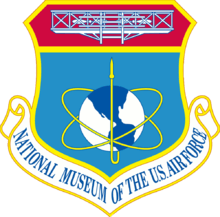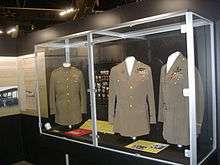National Museum of the United States Air Force
 | |
| Established | 1923 |
|---|---|
| Location |
Wright-Patterson Air Force Base, Dayton, Ohio |
| Coordinates | 39°46′55″N 84°06′32″W / 39.781976°N 84.108892°W |
| Type | Aviation museum |
| Visitors | 1,000,000+[1] |
| Director | Lt Gen John L. Hudson, USAF (Retired) |
| Curator | Terry Aitken |
| Public transit access | Greater Dayton RTA Route 11 |
| Website | www.nationalmuseum.af.mil |

The National Museum of the United States Air Force (formerly the United States Air Force Museum) is the official museum of the United States Air Force located at Wright-Patterson Air Force Base, 6 miles (9.7 km) northeast of Dayton, Ohio.[2] The NMUSAF has one of the world's largest collections with more than 360 aircraft and missiles on display.[1] The museum draws more than 1.3 million visitors each year, making it one of the most frequently visited tourist attractions in Ohio.[3]
History
The museum dates to 1923, when the Engineering Division at Dayton's McCook Field first collected technical artifacts for preservation. In 1927 it moved to then-Wright Field in a laboratory building. In 1932 the collection was named the Army Aeronautical Museum and placed in a WPA building from 1935 until World War II. In 1948 the collection remained private as the Air Force Technical Museum.[4] In 1954 the Air Force Museum became public and was housed in its first permanent facility, Building 89 of the former Patterson Field in Fairborn, which had been an engine overhaul hangar. Many of its aircraft were parked outside and exposed to the weather. It remained there until 1971, when the current facility first opened. Not including its annex on Wright Field proper, the museum has more than tripled in square footage since its inception in 1971 with the addition of a second hangar in 1988, third in 2003, and fourth in 2016.[5][6]
The museum announced a new name for the facility in October 2004. The former name, United States Air Force Museum, changed to National Museum of the United States Air Force.[1]
The museum is a central component of the National Aviation Heritage Area.[7]
Exhibits and collections
The museum's collection contains many rare aircraft of historical or technological importance and various memorabilia and artifacts from the history and development of aviation. Among them is one of four surviving Convair B-36 Peacemakers, the only surviving North American XB-70 Valkyrie and Bockscar—the Boeing B-29 Superfortress that dropped the Fat Man atomic bomb on Nagasaki during the last days of World War II.
In 2010, the museum launched its 360-degree Virtual Tour, allowing most aircraft and exhibits to be viewed online.
Presidential aircraft
The museum has several Presidential aircraft, including those used by Franklin D. Roosevelt, Harry Truman and Dwight D. Eisenhower. The centerpiece of the presidential aircraft collection is SAM 26000, a modified Boeing 707 known as a VC-137C, used regularly by Presidents John F. Kennedy, Lyndon B. Johnson and Richard Nixon. It became the backup presidential aircraft after Nixon's first term. This aircraft took President and Mrs. Kennedy to Dallas on November 22, 1963—the day of the President's assassination. Vice President Johnson was sworn in as president aboard it shortly after the assassination, and the aircraft then carried Kennedy's body back to Washington.[8] It was temporarily removed from display on December 5, 2009, repainted and returned to display on President's Day in 2010.[9]
All presidential aircraft are now displayed in the Presidential Gallery, in the new fourth building.[10]
Pioneers of flight
A large section of the museum is dedicated to pioneers of flight, especially the Wright Brothers, who conducted some of their experiments at nearby Huffman Prairie. A replica of the Wrights' 1909 Military Flyer is on display, as well as other Wright brothers artifacts. The building also hosts the National Aviation Hall of Fame, which includes several educational exhibits.
Uniforms and clothing

The museum has many pieces of U.S. Army Air Forces and U.S. Air Force clothing and uniforms. At any time, more than 50 World War II-vintage A-2 leather flying jackets are on display, many of which belonged to famous figures in Air Force history. Others are painted to depict the air planes and missions flown by their former owners. The displays include the jacket worn by Brigadier General James Stewart, P-38 ace Major Richard I. Bong's sheepskin B-3 jacket and boots, an A-2 jacket worn by one of the few USAAF pilots to leave the ground during the attack on Pearl Harbor, and President Ronald Reagan's USAAF peacoat.
Other exhibits and attractions
The museum completed the construction of a third hangar and hall of missiles in 2004. It now houses post-Cold War era planes such as the Northrop Grumman B-2 Spirit stealth bomber (test aircraft), the Lockheed F-117 Nighthawk stealth ground attack aircraft and others. A fourth hangar was completed in 2016 to house the museum's space collection, presidential planes, and an enlarged educational outreach area. Previously these collections were housed in an annex requiring a bus trip onto WPAFB.
The museum has an IMAX theater that shows, for a fee, aviation- and space-oriented IMAX films interspersed primarily with other documentaries.
The museum owns other USAF aircraft, including former U.S. Army Air Service, USAAC or USAAF aircraft, that are on loan to other aerospace museums in the United States and overseas, as well as those on permanent static display at various U.S. Air Force installations and tenant activities worldwide and at Air Force Reserve and Air National Guard installations across the United States. The museum also oversees those aircraft, missiles and associated artifacts loaned to communities or civic organizations for display at civilian airports (many of them former USAAF and/or USAF bases), public parks and memorials, the facilities of military-affiliated organizations (e.g., VFW, American Legion, etc.), or in other similar venues. Most of these loaned aircraft duplicate aircraft exhibited by the museum. These other aircraft continue to remain the property of the Department of the Air Force and are typically identified at these locations as being "On Loan from the National Museum of the U.S. Air Force." The museum's staff has very high standards for the restoration and quality of care of loaned assets and has, in the past, revoked these loans when it was deemed that these other museums did not have the resources to properly care for an artifact. This happened in the case of the famous Boeing B-17 Flying Fortress, Memphis Belle.
Future developments
The National Museum of the U.S. Air Force is in the midst of a multi-phase, long-term expansion plan. The Air Force Museum Foundation recently supported a major capital construction program that expand the museum to the current 1 million square feet of exhibit space with the fourth building that now houses the Space Gallery, Presidential Aircraft Gallery and Global Reach Gallery.
In 2013, the Air Force Museum Theater upgraded its theater from IMAX to digital 3D. This upgrade included a new stage, theater seats and a new theater screen to support a broader range of programming—including educational presentations, live broadcasts and expanded documentary choices. The renovations include a 7.1 surround-sound system, audio devices for the hearing or visually impaired, and personal closed captioning systems.[11]
On 8 June 2016, the newest addition to the museum was formally opened.[12][13][14][15] The new building is large in size, containing 224,000 square feet (68,275 square metres) of space, and runs parallel to the building it grew out of, "Hangar 3". With the addition of new space, more than 70 aircraft previously in storage have been able to be put back on display, such as the XB-70 Valkyrie.[16][17][18] The Presidential Aircraft collection is also now back on site, having been moved to an outside location for some time.[19]
The new building's construction was entirely funded via private donations from several different sources.[20]
Partial list of collection
The museum is divided into galleries that cover broad historic trends in military aviation. These are further broken down into exhibits that detail specific historical periods and display aircraft in historical context.
Air Force Museum Foundation
The Air Force Museum Foundation is a private, non-profit organization that supports the mission and goals of the National Museum of the U.S. Air Force.[21]
Other Air Force museums
See also
- American Air Museum in Britain
- CAF Airpower Museum
- Mighty Eighth Air Force Museum
- Military Aviation Museum
- National Museum of the Marine Corps
- National Museum of Naval Aviation (the U.S. Navy's equivalent facility to the NMUSAF)
- National Museum of the United States Army
- National Museum of the United States Navy
- Octave Chanute Aerospace Museum
- Patuxent River Naval Air Museum
- United States Air Force Memorial
- War in the Pacific National Historical Park
- Wings of Freedom Aviation Museum
- Related lists
References
- 1 2 3 "History of the National Museum of the United States Air Force". National Museum of the United States Air Force official site. June 2007. Retrieved 2008-09-12.
- ↑ "Visitor info". Retrieved 23 November 2011.
- ↑ "Airfoce Museum Attendance". Retrieved 2009-04-05.
- ↑ US Air Force Museum Foundation (1972). US Air Force Museum.
- ↑ Air Force Museum Foundation
- ↑ "Expanding the Legacy". Issuu. Air Force Museum Foundation. p. 19. Retrieved 31 December 2015.
- ↑ "Home of the Wright Brothers". National Aviation Heritage Area. Retrieved 16 March 2012.
- ↑ Keen, Judy (November 20, 2009). "JFK Relics Stir Strong Emotions". USA Today. Retrieved 20 November 2009.
- ↑ "Air Force One temporarily off display at the National Museum of the U.S. Air Force". National Museum of the US Air Force. September 22, 2009.
- ↑ "National Museum of the U.S. Air Force fourth building now open".
- ↑
- ↑
- ↑
- ↑
- ↑
- ↑
- ↑
- ↑
- ↑
- ↑
- ↑ Air Force Museum Foundation. Retrieved 2010-02-04.
External links
| Wikimedia Commons has media related to National Museum of the United States Air Force. |
- National Museum of the United States Air Force official website
- Air Force Museum Foundation official website
- SR-71 Online – National Museum of The United States Air Force – A guide to the museum and its displays.
- US Air Force Museum Photos – Photos of exhibits in the National Museum of the USAF in Dayton, OH
- Photo website with 360-degree VR panoramas and HDR images
Coordinates: 39°46′55″N 84°06′32″W / 39.781976°N 84.108892°W
